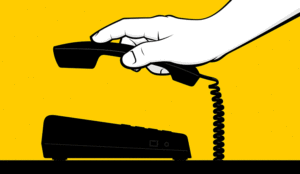Call abandonment rate refers to the percentage of customers who hang up before they are connected to an agent.
It is one of the most important metrics for evaluating contact centre performance, and a useful indicator of the overall experience for customers, providing insight into what they prefer and how satisfied they are with their contact centre interactions.
A high abandonment rate can be indicative of long queue times, complicated entry procedures, and unsatisfactory service options.
Monitoring this metric over time will allow you to spot patterns of abandonment which can be addressed through staffing or technology-based solutions, while tracking the abandonment rate in real time allows you to tackle issues as they arise and prevent them from escalating.
What’s the Definition of Call Abandonment Rate?
Call abandonment rate refers to the percentage of customers who hang up on a call before they are connected to an agent.
What’s the Formula for Calculating Call Abandonment Rate?
To calculate the call abandonment rate take the number of calls received and subtract the number of calls which were answered, divide this result by the number of received calls, and multiply by 100 to get a percentage.
You can track the abandonment rate across whatever period is appropriate and compare the trends from one time period to the next.
It’s important to remember that the percentage figure doesn’t tell the whole story. You should dive into the meaning behind the numbers to get a real sense of why the abandonment rate is what it is.
A Look at Call Centre Abandonment Rate Benchmarks
For contact centres, a call abandonment rate of between 5% and 8% is the industry standard. Anything in this range is acceptable, but if the rate hits 10% or higher it’s time to sit up and take notice.
These are the average numbers for a contact centre, but across different industries the rate can even exceed 20% based on the time of day. Other metrics can also influence the call abandonment rate, including:
- Average response time
- Call forecast variance
- Observance of work schedule
- Occupancy rate
- Call duration
- Customer satisfaction
- First call resolution
There are also other reasons why a customer may hang up on a call before connecting:
- The customer was waiting too long for a response, so they looked elsewhere or just gave up.
- While waiting on the line, the customer figured out the solution on their own.
- The customer decided that the contact centre agent would not be able to help with their problem, so they abandoned the call.
- Some aspect of the call process irritated the customer, so they hung up.
- Something in the customer’s personal life took precedence so they had to abandon the call for the moment.
What Can We Do to Lower Call Abandonment Rate?
There are many approaches you can take to lower the call abandonment rate and improve the overall health of your contact centre.
Remember that an abandoned call isn’t necessarily a lost cause, you can always take steps to salvage the situation and make sure that the customer has a positive experience in the end.
If the possibility of further communication remains, the interaction can still be rescued.
Open a “Virtual Queue” and Offer Callbacks
Nobody likes to be put on hold. Instead of making a customer sit there twiddling their thumbs and listening to hold music, place them in a “virtual queue.”
This refers to the practice of adding a customer to a virtual queue, where they will remain in line to speak to an agent without having to remain on the phone. Instead, once they reach the front of the virtual queue, an available agent will call them back.
This frees up the customer to go about their day and is more likely to keep them in a positive mindset for the actual agent–customer interaction.
Depending on your virtual queueing system, you may also be able to capture some general information about the customer’s query so that the agent is better prepared to resolve the issue quickly when they connect with the customer.
A virtual queue system also allows agents to give their full attention to their current interaction, rather than worrying about other customers who are on hold.
If possible, you should also offer customers the ability to pick a time slot for their callback or cancel their callback if they no longer need to speak to an agent.
Offer Self-Service
With self-service options, you can reduce your contact centre’s call load and relieve the burden on agents. This helps to lower call abandonment rate, as agents have more time to resolve issues for those customers who need to speak to a live person.
Self-service tools like AI-driven chatbots, FAQs, knowledge bases, support portals, training platforms and explainer videos are increasingly popular ways to resolve customer issues outside of the traditional phone call method. Implementing self-service options can lead to reduced agent workload, faster query resolutions, fewer phone queries, and more opportunities for automated upselling and cross-selling.
The self-service approach can also be beneficial for customers, offering greater convenience and empowering them to solve their own problems.
For low-effort, non-urgent tasks a phone call isn’t always necessary, and most customers will prefer to just do it themselves.
However, it’s important to remember that AI conversations can become rigid when handling more complex scenarios, so an easy choice to switch to a live interaction should be available if needed.
Additionally, you should remember to update self-service tools as your product evolves. Self-service tools which supply outdated information could lead to further confusion for the customer and increase the call load.
Manage Staff for Busier Times
Effective scheduling is another way to keep the abandonment rate under control and ensure that agents are equipped to deal with the call load.
Make sure enough staff are available to handle the call load at peak times or average waiting times could begin to rise rapidly, driving up the abandonment rate and negatively impacting customer satisfaction levels. Using historical data to find call patterns and trends can help with the scheduling process.
In addition to optimal scheduling, supervisors should keep an eye on their agents and make sure that they are handling their calls effectively, with no time wastage. If necessary, a supervisor could even jump on a call and free up an agent to assist another customer.
Automate Repetitive Tasks
Automation of repetitive tasks will free up more time for agents to focus on the important part of the job—speaking to customers and resolving their issues in a prompt, effective manner.
It’s also better for agent morale and team spirit. Allowing agents to focus on the more interesting, rewarding parts of the job rather than mundane, repetitive tasks will improve their performance and lead to better agent-customer interactions and a lower call abandonment rate.
Use the Right Technology
The implementation of technology can ease the agent workload, streamline the support process, and optimize the overall contact centre workflow for improved performance and results.
Supervisors can use workflow management software to effectively direct calls to agents and reduce queuing times for customers.
AI-driven self-service tools like chatbots can relieve the burden on agents and lead to a lower call abandonment rate.
Additionally, quality assurance tools like Scorebuddy can be used to track and improve agent performance, leading to better response times, a higher rate of first-call resolution, and a lower average handling time, all of which contribute to improvements in call abandonment rate.
Final Thoughts
Call abandonment rate is one of the most important metrics we have for evaluating contact centre performance.
A high call abandonment rate can be an indicator of deeper problems with the overall health of a contact centre, such as long queue times, complicated entry procedures, and poor customer service options.
Fortunately, there are plenty of different staffing and technology-based solutions you can implement to lower the call abandonment rate over time and improve the overall customer experience.
This blog post has been re-published by kind permission of Scorebuddy – View the Original Article
For more information about Scorebuddy - visit the Scorebuddy Website
Call Centre Helper is not responsible for the content of these guest blog posts. The opinions expressed in this article are those of the author, and do not necessarily reflect those of Call Centre Helper.
Author: Scorebuddy
Published On: 6th Sep 2022
Read more about - Guest Blogs, Scorebuddy






 Scorebuddy is quality assurance solution for scoring customer service calls, emails and web chat. It is a dedicated, stand-alone staff scoring system based in the cloud, requiring no integration.
Scorebuddy is quality assurance solution for scoring customer service calls, emails and web chat. It is a dedicated, stand-alone staff scoring system based in the cloud, requiring no integration. 





























